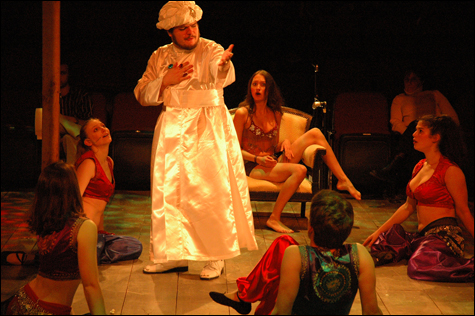
A MAN AND HIS HAREM: Patrick Harrison takes his turn as Peer. |
On stage there’s nothing like a bad boy, mugging brazenly like Mick Jagger or hurtling toward comeuppance like a medieval morality play sinner. With the infrequently staged Peer Gynt, Henrik Ibsen set the bar high for flamboyant reprobates in modern theater, as Brown Theatre and Sock & Buskin are demonstrating at the Stuart Theatre through March 16.
We follow the adventures of Peer from the time of his imaginary, tall-tale exploits as a boy, frightening his mother with a vivid account of hunting a stag. By the time he is an old man, two acts and two intermissions later, he has gained and lost two fortunes and survived a couple of shipwrecks, yet it’s questionable whether he has learned anything about moral behavior that has stuck.
We’re hearing the rhymed verse translation by Gerry Bamman and Irene B. Berman, adapted and directed by John Emigh. This three-hour production isn’t quite the 4-1/2-hour endurance contest that the full text of the original would have been. But that version seems intentionally unstageable, as the director points out in his informative program note. Ibsen, we are told, first published this in 1867 as a “dramatic poem,” more or less a conceptual art proposal requiring 60 actors plus a chorus.
At Brown we get 15 actors, two violinists (Ida Mae Specker and Sarah Tolan-Mee), and the lovely voice of a singer (Nora Blackall). But besides a mercilessly trimmed text, Emigh provides his specialty, masks and puppets, designed by Brian Gaston, Erminio Pinque, and Sophie Tintori. The main opportunity for them is when Peer joins the carbuncle-nosed trolls in the mountains and lots of Big Nazo homunculi are Hobbitting about. Peer Gynt is especially appropriate for masks in that the title character is having a lifelong identity crisis that makes David Bowie look like Emily Dickinson.
For that reason, no fewer than 10 actors and one piñata play Peer in the Brown production. He tries on different personas upon different opportunities, and as he gets older, his personality softens and adjusts to circumstances. (Trinity Rep staged Peer Gynt in 1998, with Fred Sullivan Jr. and Timothy Crowe similarly sharing the role, in the adaptation by David Henry Hwang and Stephen Müller, who directed.)
Emigh uses the multiple Peer device thoughtfully throughout the play. For example, at the beginning a relatively boyish Chris Tyler leaps and twirls about the stage, impressing his mother with his supposed battle with the stag. Prompted by her, he crashes a wedding party and convinces the bride to run off with him, after morphing into a swarthier, edgier Douglas Benedicto. (It’s especially important to stress that switch from playful to predatory, since Peer heartlessly abandons her after they’ve dallied a while.) Other internal and external changes are less dramatic, with the exception of Jonathan Dent briefly portraying Peer in an angry hip-hop rap, complete with a circle of hooded homies.
The one character that pointedly remains the same, played by the same actor, is Jing Xu’s Solveig. Peer asked her to dance with him at that wedding and, despite his abandoning her, she remains in love with him throughout his life. Toward the end, when he asks her where he has been, the essence of him, during all of his changes, Solveig points to her heart.
That’s a wise observation, which is largely lost on Peer but stays with us. This throughline concern with identity holds together what otherwise is a rather patchy plot. The Troll King (Patrick Harrison) he meets says that the difference between men and trolls is that the former seek “to thine own self be true,” while trolls say, “to thine own self be enough.” Poor Peer, as he peels a metaphorical and literal onion at the conclusion, knows that he never made much of the potential difference.
Ibsen wasn’t in his irrepressible, nostril-flaring youth when he wrote this — he was approaching 40, an old Turk. The playwright apparently got a lot out of his system by writing Peer Gynt, so experimental that it was designed to be imagined rather than actually staged — one act was supposed to be performed completely in the dark. Twelve years and four plays later, A Doll’s House was produced, and Ibsen’s place as the progenitor of modern dramatic realism was assured. This production is a fascinating glimpse into the playwright’s imagination. It could be fun for those willing to forgo linear narrative and roll with the flow of creative process.